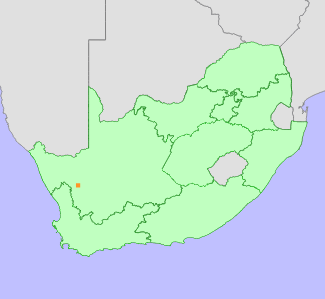|
Scientific Name | Conophytum concordans G.D.Rowley |
Higher Classification | Dicotyledons |
Family | AIZOACEAE |
Synonyms | Ophthalmophyllum villetii L.Bolus |
National Status |
Status and Criteria | Endangered A3cd |
Assessment Date | 2021/11/19 |
Assessor(s) | A.J. Young, P.G. Desmet, I. Ebrahim, D. Guo, A. Harrower, L. Jabar, L. Knoetze, C. Rodgerson, P.C.V. Van Wyk & N.N. Mhlongo |
Justification | This succulent is endemic to the Northern Cape province of South Africa with an extent of occurrence (EOO) and area of occupancy (AOO) of 12 km². The dwarf succulents that comprise this genus have been increasingly targeted by illegal collection in recent years and the vast majority of species are in high demand by collectors. Whilst there is no evidence of illegal collection at the time of this submission, closely related species have been illegally removed from habitat with a dramatic increase in the number of species and volume of plants targeted since 2019. The threat of illegal collection is therefore regarded as high for this particular species. Whilst its restricted distribution makes it susceptible to collection, the highly cryptic, semi-subterranean habit of the plants may limit this. A decline of up to 75% of the population is likely within the next three generations (90 years) due to illegal collection. Climate change is also highly likely to impact the population although there is uncertainty of the response given the expected resilience of this species. This species therefore qualifies as Endangered under criterion A3. |
Distribution |
Endemism | South African endemic |
Provincial distribution | Northern Cape |
Range | This species is endemic to a small part of the Northern Cape province of South Africa where it is only found in two locations with a restricted geographic range. |
Habitat and Ecology |
Major system | Terrestrial |
Major habitats | Namaqualand Klipkoppe Shrubland, Northern Knersvlakte Vygieveld |
Description | This species is found in the Succulent Karoo biome, Namaqualand Hardeveld Bioregion. It is endemic to Namaqualand Blomveld. The plants inhabit small, flat, isolated, patches of broken gneiss. Their habit is semi-subterranean and the plants can be very cryptic. This species has a generation length of 30 years. It is expected to be sensitive to the impacts of climate change as it does not disperse and while adapted to arid conditions, is dependent on limited seasonal rainfall. Species in the genus are sensitive to long periods of drought. Drought related mortality has been observed for other closely related taxa within the genus. |
Threats |
| This species is is likely to be threatened in the near future by illegal collection for the international trade in ornamental succulents, as there has been a dramatic increase in the number of species and volume of plants within the genus Conophytum targeted since 2019. Grazing and trampling by livestock is a potential minor treat.
Anthropogenic climate change is a long-term threat to this species. While it is not possible to model the response of this species to climate change due to its restricted distribution, the average loss to climate change for 15 more widely distributed Conophytum species occurring within the same region is used as an indication of likely impact to this species. Climate models for the likely emission scenarios where emissions stay at present day levels (RCP 2.6) (Hausfather and Peters 2020) and worst case scenarios where emissions continue to increase during the 21st century (RCP 8.5) indicate that there will be a loss of suitable bioclimatic envelope of between 72% and 99% by 2080 for Conophytum taxa within the region. However, as this taxon possesses certain traits likely to afford resilience to xerophytic conditions it is expected to have a level of resilience to climate change and the expected population loss is reduced by 20% to 52% based on the uncertainty of the response given the expected resilience of this taxon. Species in this genus have limited dispersal ability and migration to suitable habitats elsewhere is regarded as highly unlikely. |
Population |
This species was not observed in habitat for many years but one subpopulation consisting of approx. 1,000 mature individuals was discovered in 2019. At least one other subpopulation has been reported but not seen recently. The total population is therefore estimated at 1,000-2,500 mature individuals. The remoteness of the area and the fact that the plants are highly cryptic for much of the year could mean that population size has been underestimated. The population is not known to be declining.
|
Population trend | Unknown |
Assessment History |
Taxon assessed |
Status and Criteria |
Citation/Red List version | | Conophytum concordans G.D.Rowley | Rare | Raimondo et al. (2009) | | Ophthalmophyllum villetii L.Bolus | Rare | Hilton-Taylor (1996) | | Ophthalmophyllum villetii L.Bolus | Indeterminate | Hall et al. (1980) | |
Bibliography |
Hammer, S. 2002. Dumpling and his wife: New view of the genus Conophytum. EAE Creative Colour, Norwich.
Hammer, S.A. 1993. The genus Conophytum: A conograph. Succulent Plant Publications, Pretoria.
Hausfather, Z. and Peters, G.P. 2020. Emissions - the 'business as usual' story is misleading. Nature 577(618-620).
Opel, M.R. 2004. The rediscovery of Crassula alcicornis. Haseltonia 10:38-40.
|
Citation |
| Young, A.J., Desmet, P.G., Ebrahim, I., Guo, D., Harrower, A., Jabar, L., Knoetze, L., Rodgerson, C., Van Wyk, P.C.V. & Mhlongo, N.N. 2021. Conophytum concordans G.D.Rowley. National Assessment: Red List of South African Plants version 2024.1. Accessed on 2025/11/07 |
 Comment on this assessment
Comment on this assessment


